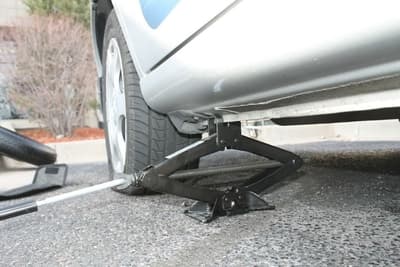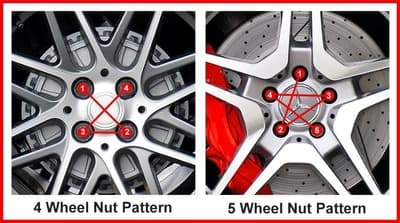How to change a tyre
Most new cars come without a spare wheel these days, but if your vehicle picks up a puncture and has a spare wheel, would you know how to change it?

When a tyre picks up a puncture this can cause loss of vehicle control or at worst a tyre blow out and this can be very scary. Changing a tyre can also be very scary, but maybe the best option to get you home safely or to a garage.
We do not recommend you drive your vehicle with a flat tyre or a puncture as this can cause more damage and potentially damage your wheel unless you are in a dangerous location and need to move your vehicle to a safer place.
Adding some air pressure into the damaged tyre before driving your vehicle may reduce the risk of damaging your wheel and may even save your tyre, but only do this if it is safe to do so.
What should I do if I get a puncture?
If you have a tyre pressure warning light on your dashboard or you start to lose control of your vehicle you may have a puncture and we would strongly advise that you pull over as soon as safely possible. If your tyre has gone flat you may need to change the wheel with your spare wheel (if you have one), most new vehicles do not have a spare wheel, instead, they have emergency tyre repair kits, which will consist of a sealant and compressor. The repair sealant is forced into the tyre via the tyre valve and plugs the puncture from inside.
Please note tyre sealant repairs are only a temporary fix and your vehicle will still need to be taken to a garage to have the puncture repaired or the tyre replaced, as some sealants cannot be removed.
Related: Dashboard Warning Lights
If your tyre is flat and your vehicle has a spare wheel, you would be advised to swap the wheels over before taking your vehicle to a garage. Do not attempt to change a tyre if you are in a dangerous location, that includes motorway hard shoulders, as this could endanger the lives of other motorists and yourself. If you find yourself in a dangerous location call your breakdown service out or on the motorway call for assistance via the emergency telephone points. Please do not stay in your vehicle and move to a safe location until assistance arrives.
We would suggest keeping extra layers of clothing in your car in the event of an emergency.
If your vehicle has a spare wheel, it is often a space-saver wheel, which is quite a bit thinner than your standard wheel, however, some vehicles are supplied with a full-size spare wheel.
Learning how to change a wheel is a great life skill, so we’ve put together a guide to help you do this.
Get your vehicle ready
- Move your vehicle to a safe location
- Make sure your vehicle’s handbrake is firmly on and there are no passengers in the car.
- Put your hazard warning lights on or put a red warning triangle behind your vehicle (if you have one).
- Remove the spare wheel, which should include a small jack and wheel brace.
- If you have a wheel chock, put it in front or behind the wheel opposite/adjacent to your punctured tyre, to stop your vehicle from rolling.
- If your vehicle has locking wheel nuts, you will need to find your locking wheel nut key, which is often found in your glove box or boot.
- Use gloves if you have them, as your wheel will be dirty.
Removing the punctured tyre
- Firstly, loosen your wheel nuts with the wheel brace while the wheel is still on the ground, but don’t remove them completely. If you have locking wheel nuts you will need to fit the locking wheel nut key onto your wheel nut and then attach the wheel brace. To untighten the nuts you will need to turn the wheel brace anti-clockwise.
- Position your wheel jack underneath the sill closest to your puncture, you should notice jacking points in the sill. Make sure the wheel chock is secure (if you are using one) and jack your vehicle up until your punctured tyre is off the ground, roughly 10-15cm above.
- Remove the wheel nuts and put them in a safe place, then remove the tyre carefully and place it on its side to prevent it from rolling away.
Putting on the spare wheel
- Put the spare wheel onto the wheel bolts or slots and replace the wheel nuts
- Finger tighten your wheel nuts slightly, not with the wheel brace.
- Release your jack slowly to lower your vehicle until the spare tyre touches the ground, then tighten the wheel nuts with your wheel brace in the order below:

- Lower your vehicle fully, so that the wheel jack can be removed.
- Make sure to put your locking wheel nut (if you have one) back in the glove box or boot and put the wheel jack and wheel brace back in your vehicle.
- Safely put your punctured wheel in your vehicle ready to be taken to a garage, this can be quite dirty, so it’s sometimes handy to have an old sheet or some plastic bags in your vehicle to lay the tyre on.
Final checks
You will need to check the tyre on your spare wheel has the correct tyre pressure, you can do this yourself if you have a tyre pressure gauge or drive to your nearest petrol station to check the tyre pressure before taking your vehicle to a garage for repair.
Vehicles with a spare wheel don’t normally come with a tyre pressure compressor, so it may be a good idea to purchase one for emergencies.
Related: Tyre Pressures
Please note space-saver spare wheels (which are thinner) can only be used in an emergency and for short distances at a maximum speed of 50mph.
Please note your vehicle will fail an MOT if you have a space-saver spare wheel on.
Related: MOT Checklist
Can I have my flat tyre replaced at home?
At National, we offer a Mobile Tyre Fitting service for replacement tyres, these can be fitted at your home or work. Unfortunately, our Mobile Tyre Fitting service cannot repair tyres at home or work, you would need to bring your tyre or vehicle to one of our branches for repair.
Related: Mobile Tyre Fitting
What are Run Flat tyres?
Lots of cars these days are supplied with Run Flat tyres as original equipment, these are intelligent tyres that repair themselves if you pick up a puncture, reducing your risk of losing vehicle control or a tyre blow out and allows you to carry on your journey for up to 50 miles up to a maximum of 50mph.
Can you repair Run Flat tyres?
Most tyre manufacturers advise against repairing run flat tyres and most tyre retailers including National will not repair a run flat tyre after a puncture.
Related: Run Flat Tyres
We hope this information is helpful. Please feel free to discuss any tyre queries with a tyre technician in one of our National Tyres and Autocare branches, we are here to help keep you safe on our roads.
Did you enjoy this blog post? |1 people found this review helpful



 Sign up for SPECIAL OFFERS
Sign up for SPECIAL OFFERS
